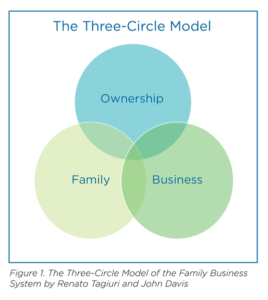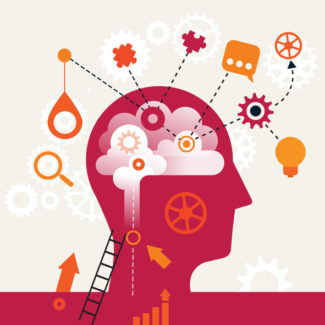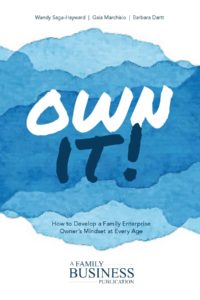Family enterprises matter, not only to the families who own them but to the communities in which they operate and the broader global economy. Their health and growth have a large impact on every country’s economic welfare. In fact, the top 500 family firms equal the world’s third-largest economy, employing about 25 million people, with total revenues of almost US$7 trillion. [1]
Because effective owners and owner teams have a material impact on the outcomes of their enterprises and, by extension, for the lives and economies they impact, the role of owner must not be taken for granted.
Consider these questions from family members when asked about ownership in their family enterprise:
“My parents did a great job separating business from family – we never talked about it at the dinner table. And I kind of wish we had. I earned a history degree, which has no relevance to the family business. How can I contribute without knowing anything about the industry?“
“My nephew never seemed a great fit for the business. But who was I to tell his dad, my brother-in-law, my concerns? Now my son is a partner with that nephew and the fit is still very poor. How could I have shared those early fears?”
“I really like my life. It’s full with my job and family. How much time will this ownership ‘thing’ take? And if my brother works in the business and I don’t, what do even have to offer?”
“This business is so special to me. My parents and uncles sacrificed to get it through some really tough times. And my sister’s husband looks at it like an ATM. How are we supposed to lead this business into the future together when all he cares about is getting a distribution?”
Why Ownership Roles are Overlooked

Ownership as a distinct role is often overlooked in the early stages of family business when ownership and management are one and the same.
This early overlap drives a common perspective that the only way to protect the business is to concentrate control in the hands of a few family members who work in the business. “How could non-managing owners know enough to be effective owners,” is a familiar refrain. This bias towards consolidation of control in family members working in the business perpetuates the lack of focus on the development of non-operating owners. In addition, it causes confusion when the rising generation is asked to choose if they are “in or out” of the business because this limits the option to participate to one type of ownership: an operating owner.
The Owner Role
Owner decisions are few and far between. Additionally, they focus on highly technical and complex topics including creating shareholder agreements, large acquisitions, debt, the sale of the business, and dealing with prenuptial agreements. Although ownership decisions are less frequent, more complex, and potentially more difficult, they also have deeper, broader, and longer-term implications than management decisions do. Ultimately, owners decide where to invest their financial assets and whether to keep, grow, or sell the business. The importance of the owner’s role is akin to the rudder on a ship: it provides an enterprise with overall direction setting its fundamental purpose and financial goals. Adequately preparing owners to make these infrequent but considerable decisions takes time, persistence and deliberate attention.
Additionally, as generations progress, we often witness the coexistence of different types of owners. A host of differentiating factors such as time, commitment, emotional attachment, participation in governance and decision-making, involvement in management, expectations, legacy orientation, and level of expertise distinguish the various owner types. An inclusive concept of ownership embraces a range of owner types — ones that encompass skills in the typical, more technical aspects (possession, decision-making, and economic returns) as well as the inspirational pieces (stewardship of legacy, contributing to the community and world, support of family, caring, and active participation).
Enterprising families understand that ownership may contribute to an individual’s life purpose and personal growth. These families allow the rising generation to choose the type of ownership they aspire to. The appreciation and inclusion of different ownership types in a family enterprise fosters greater alignment and leads to the development of effective shareholders. Some families may not yet know what type of future owners they will have. This should not be a barrier to grooming the rising generation of potential owners. Understanding the nuances of the different types enables family enterprise leaders to create deliberate choices around alternative ways to participate and clearly guide individuals who want to calibrate their level of involvement.
“A family enterprise owner’s mindset fosters effective owners (and owner teams) and offers a greater chance of success in operating and transitioning a family enterprise.”
Developing an Owner’s Mindset
While development of specialized knowledge and skills are necessary to create truly effective owners, they are not sufficient, especially in the case of shared control. We advocate for purposefully building an owner’s mindset in all owners and prospective owners.
A mindset is a set of beliefs, which drive and shape what we do, how we engage with others, and how we behave in every moment and situation[2]. A mindset profoundly impacts our results because it shapes every action we take. Those who attempt to improve by changing their mindset instead of changing their behavior are four times more likely to succeed.[3]
All owners have a mindset, but not all mindsets lead to success in a family enterprise. Below, we introduce below the key elements of a family enterprise owner’s mindset which, from our experience, fosters effective owners (and owner teams) and offers a greater chance of success in operating and transitioning a family enterprise.[4]
- Development is a continuous individual and collective process. Development is not only an individual endeavor but also a collective process that builds a family’s human, intellectual, social, financial, and spiritual capitals[5]. It happens at every life stage and has no finish line.
- Ownership requires deep commitment and responsibility. Those with an owner’s mindset see the role of an owner as an important one that requires time and investment from which they derive personal satisfaction and energy.
- Proactivity is paramount. An owner’s mindset entails being proactive and resourceful: it involves learning, engaging others, tackling challenges, and actively taking steps to get things done. Owners take initiative by anticipating and preparing for future challenges.
- Abundance rather than scarcity. Individuals and organizations have a worldview as “inherently resource-rich or resource-poor,” or anywhere in between. Those with an owner’s mindset believe that there is always more available to individuals, expect openness and trust, think big, are thankful, and learn from others.
- Win-win solutions. An owner’s mindset is characterized by understanding the importance of thinking and acting “together” to become linked as a “we” while becoming differentiated as a collection of “me’s.”[6] These owners intentionally and continuously manage the delicate balance between individualism and collectivism. This tension assumes critical importance for families who share economic interests, especially for those belonging to individualistic cultures[7]. But instead of leaning toward one at the expense of the other, those with an owner’s mindset design creative solutions resulting in mutually beneficial outcomes.
- Diversity and inclusion matter. Diversity comes in many forms: gender, race, religion, sexual orientation, age, culture, socioeconomic background, generation, personality type, intelligences and others. Decision-making, when made with diverse viewpoints, has been shown to increase business objectivity, analytical thinking, innovation and financial performance.[8] Those with an owner’s mindset embrace people with a variety of differences and, in short, they see diversity as a tremendous strength.
- Stronger Together than Apart. Those with an owner’s mindset understand they can’t do it all themselves. More importantly, they don’t want to do it all themselves. Instead, they are interested in collaborating in work and decision-making. They value both independence and togetherness[9] and sincerely appreciate being in business with other family members.[10]
Development as a Lifelong Process
We take a broad view of development. As we’ve stated, family members with an owner’s mindset treat learning as a lifelong process. They constantly assess their capabilities, improve their awareness, consider their role and responsibilities, and set goals to maximize their contribution to their family enterprise. A wide range of activities and experiences contribute to developing owners’ skillset and mindset, which can occur at individual and collective family levels. For example, family members individually take courses, attend conferences, and complete on-the-job training. Likewise, the family can develop their collective capacity through focused discussion, workshops, and skill-building activities to deepen their relationships and advance their capability as a family.
Conclusion
If you think about ownership development as we have discussed here, it can feel like having to figure out how to eat the proverbial elephant — lots of information to digest, areas to assess, and action plans to create. We know that can be overwhelming. But remember the advice on how best to eat the elephant: one bite at a time. We recommend approaching ownership development by starting small and slow – with a big vision for change. That will help you take early steps and gain momentum.
Building an owner’s mindset takes intention, time and effort at each stage of life and over the generations. And the reward of this hard work are cohesive, collaborative owner teams that advance the lives of their members, their enterprises and the communities and economies they inhabit.
To learn more, read the authors’ new book: Own It! Developing an Owner’s Mindset at Every Age.
[1] EY and University of St. Gallen Global Family Business Index. (n.d.). Retrieved from http://familybusinessindex.com/
[2] Arbinger Institute. (2016). The Outward Mindset: Seeing Beyond Ourselves. Berrett-Koehler Publishers.
[3] Boaz, N., & Fox, E. A. (2014). Change leader, change thyself. McKinsey Quarterly, 11.
[4] Shickler, S., & Waller, J. (2011). The 7 mindsets to live your ultimate life. Roswell, GA: Excent; Dweck, C. S. (2008). Mindset: The new psychology of success. Random House Digital, Inc.; Covey, S. R. (2013). The 7 habits of highly effective people: Powerful lessons in personal change. Simon and Schuster.
[5] Hughes Jr, J. E. (2010). Family Wealth: Keeping It in the Family (Vol. 34). John Wiley & Sons.
[6] Siegel, D.J. (2010). Mindsight: The new science of personal transformation. Bantam.
[7] Jaffe, D.T., & Grubman, J. (2016). Cross cultures: How global families negotiate change across generations. (1st ed.). Create Space Independent Publishing Platform.
[8] Gompers, P. & Kovvali, S. (Jul-Aug 2018). The Other Diversity Dividend. Harvard Business Review.
[9] Olson, D.H. (2000). Circumplex model of marital and family systems. Journal of Family Therapy, 22(2), 144-167.
[10] Adapted from Arbinger Institute. (2016). The outward mindset: Seeing beyond ourselves. Berrett-Koehler Publishers.


